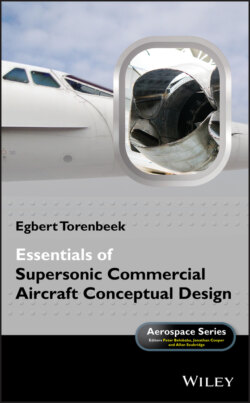Essentials of Supersonic Commercial Aircraft Conceptual Design

Реклама. ООО «ЛитРес», ИНН: 7719571260.
Оглавление
Egbert Torenbeek. Essentials of Supersonic Commercial Aircraft Conceptual Design
Table of Contents
List of Tables
List of Illustrations
Guide
Pages
Aerospace Series
Essentials of Supersonic Commercial Aircraft Conceptual Design
Foreword
Series Preface
Preface
Acknowledgements
1 History of Supersonic Transport Aircraft Development
1.1 Concorde's Development and Service
1.2 SST Development Program
1.3 Transonic Transport Configuration Studies
1.4 US High Speed Research and Development Programs
1.5 European Supersonic Research Program
1.6 A Market for a Supersonic Commercial Aircraft?
1.6.1 Why Fly Supersonically?
1.6.2 Requirements and Operations
1.6.3 Block Speed, Productivity, and Complexity
Bibliography
Note
2 The Challenges of High‐speed Flight
2.1 Top Level Requirements (TLR)
2.2 The Need for Speed
2.3 Cruise Speed Selection
2.4 Aerodynamic Design Considerations
2.4.1 Fuel and Flight Efficiency
2.4.2 Aerodynamic Efficiency
2.4.3 Power Plant Efficiency
2.4.4 Flight Efficiency
2.4.5 Cruise Altitude
Bibliography
Note
3 Weight Prediction, Optimization, and Energy Efficiency
3.1 The Unity Equation
3.2 Early Weight Prediction
3.2.1 Empty Weight
3.3 Fuel Weight
3.3.1 Mission Fuel
3.3.2 Reserve Fuel
3.4 Take‐off Weight and the Weight Growth Factor
3.5 Example of an Early Weight Prediction
3.5.1 MTOW Sensitivity
3.6 Productivity and Energy Efficiency
3.6.1 Range for Maximum Productivity
3.6.2 Energy Efficiency
3.6.3 Conclusion
Bibliography
Note
4 Aerodynamic Phenomena in Supersonic Flow
4.1 Compressibility of Atmospheric Air
4.1.1 Speed of Sound and Mach Number
4.1.2 Compressible and Incompressible Flows
4.2 Streamlines and Mach Waves
4.2.1 Sound Waves
4.3 Shock Waves
4.4 Normal Shock Waves
4.4.1 Effects of Normal Shock Waves
4.5 Planar Oblique Shock Waves
4.6 Curved and Detached Shock waves
4.7 Expansion Flows
4.8 Shock‐expansion Technique
4.9 Leading‐edge Delta Vortices
4.10 Sonic Boom
Bibliography
Notes
5 Thin Wings in Two‐dimensional Flow
5.1 Small Perturbation Flow
5.1.1 Linearized Velocity Potential Equation
5.1.2 Pressure Coefficient
5.1.3 Lift Gradient
5.1.4 Pressure Drag
5.1.5 Symmetric Airfoils with Minimum Pressure Drag
5.1.6 Total Drag
5.1.7 Center of Pressure
5.1.8 Concluding Remarks
Bibliography
6 Flat Wings in Inviscid Supersonic Flow
6.1 Classification of Edge Flows
6.2 Linear Theory for Three‐dimensional Inviscid Flow
6.2.1 Flow Reversal Theorems
6.2.2 Constant‐chord Straight Wings
6.2.3 Constant‐chord Swept Wings
6.3 Slender Wings
6.4 Delta Wing
6.4.1 Supersonic Leading Edge
6.4.2 Subsonic Leading Edge
6.5 Arrow Wings
6.6 Slender Delta and Arrow Wing Varieties
Bibliography
Notes
7 Aerodynamic Drag in Cruising Flight
7.1 Categories of Drag Contributions
7.1.1 Miscellaneous Drag Terms and the Concept Drag Area
7.1.2 Analysis Methods
7.2 Skin Friction Drag
7.2.1 Friction Coefficient
7.2.2 Flat‐plate Analogy
7.2.3 Form Drag
7.3 Slender Body Wave Drag
7.3.1 Conical Forebody Pressure Drag
7.3.2 Von Kármán's Ogive
7.3.3 Sear–Haack Body
7.4 Zero‐lift Drag of Flat Delta Wings
7.4.1 Drag due to Lift
7.4.2 Vortex‐induced Drag
7.4.3 Wave Drag Due to Lift
7.5 Wing‐alone Glide Ratio
7.5.1 Notched Trailing Edges
7.5.2 Zero‐lift Drag
7.5.3 Induced Drag
7.5.4 Minimum Glide Ratio
7.6 Fuselage‐alone Drag
7.6.1 Pressure Drag
7.6.2 Skin Friction Drag
7.6.3 Fuselage Slenderness Ratio
Bibliography
Note
8 Aerodynamic Efficiency of SCV Configurations
8.1 Interaction Between Configuration Shape and Drag
8.2 Configuration (A)
8.2.1 Slenderness ratio and lift coefficient for minimum drag
8.2.2 Cruise Altitude for Minimum Drag
8.3 Configuration B
8.3.1 Glide Ratio
8.3.2 Cruise Altitude and Wing Loading
8.4 Full‐configuration Drag
8.4.1 Configuration Glide Ratio
8.4.2 Notch Ratio Selection
8.5 Selection of the General Arrangement
8.5.1 Fore‐plane Versus After‐tail
8.5.2 Application of the Area Rule
Bibliography
Notes
9 Aerodynamics of Cambered Wings
9.1 Flat Delta Wing Lift Gradient and Induced Drag
9.1.1 Achievable Leading‐edge Thrust
9.2 Warped Wings
Bibliography
10 Oblique Wing Aircraft
10.1 Advantages of the Oblique Wing
10.2 Practical Advantages of the Oblique Wing
10.3 Oblique Wing Transport Aircraft
10.4 Oblique Flying Wing (OFW)
10.4.1 OFW Flying Qualities and Disadvantages
10.5 Conventional and OWB Configurations Compared
10.5.1 Practical Side‐effects
10.6 Conclusion
Bibliography
Index
WILEY END USER LICENSE AGREEMENT
Отрывок из книги
Egbert Torenbeek
Delft University of Technology
.....
By the early 1970s it was recognized that the higher fuel prices and risk of a transonic airplane development outweighed its potential benefits, an opinion that was widely held throughout the mid‐1990s. Around the year 2000 Boeing marketed a concept that was designed for extended ranges greater than 17,000 km, flying at cruise speeds of Mach 0.95 or above. It was derived from “slowing down” supersonic configurations rather than “speeding up” conventional subsonic configurations and became known as the “Sonic Cruiser”. This project came to an end after the events of September 2001, when airlines that were enthusiastic about the Sonic Cruiser initially were struggling for their survival.
During the 1970s and 1980s several projects of the American industry were aimed at investigating applications of NASA research of advanced supersonic configurations. Study projects were part of the supersonic cruise aircraft research (SCAR) program, focusing on a second generation of supersonic airliners transporting some 300 passengers over trans‐Pacific routes at speeds up to Mach 2.70. The SCAR Program was brought to an end by the marginal performance and economic potentials that appeared possible with the then available technology base. A resurgence of interest in a second‐generation high‐speed commercial transport (HSCT) occurred during the 1990s in Europe, the USA and Asia. Projections in 1989 for the 1995–2015 period indicated that the market in terms of passenger miles would increase by a factor of six (relative to 1971–1989) in the North‐Mid Pacific and by a factor of seven in the Far East. Based on these projections, a potential market for approximately a thousand HSCT aircraft was foreseen in 1989, well over the minimum needed for a a profitable development program launch. NASA studies concluded that a supersonic transport launched in the early 21st century could be compatible with current airports, use jet fuel, and be within ten to fifteen years' technology reach.
.....